- Could I ask you to begin by giving us an outline of the Seoul Art Space program?
-
The previous mayor of Seoul, Oh Se-Hun had a policy called Culturenomics that sought a positive fusion of culture and economics. The concept was to use culture as a force to help in community development and bring added value to the communities’ industry. It was in that context that full-fledged preparations began for establishment of Seoul Art Space (hereafter “Art Space”) facilities were started in 2008. At the time, it began from an attempt to renovate old buildings with the aim of creating culture facilities to help in urban renewal and community development. Currently there are 11 Art Space facilities, and all of them are in buildings that were headed toward being torn down, like public buildings belonging to the different Wards of the City of Seoul, such as district offices, health centers and city history archives, or unused business or factory facilities, that were recycled or purchased to open Art Spaces. In a word, the Art Space are culture facilities for connecting the arts, people and the communities and, across various genres, to encourage exchange within the communities that stimulate local culture, while also providing opportunities for people of the communities to participate in the arts. The preparation of the facilities began in 2008 and full-fledges activities and programs were started from 2009.
Let me give a simple introduction of the existing Art Spaces. In Songpa-ku Ward, there is the Seoul Art Space – Jamsil (opened 2007) that is a creative space for artists with disabilities. In Mapo-ku Ward there is the Seoul Art Space – Seogyo (2009), which is in the area of the art school Hongik University and is mainly a space for the visual arts. In Jung-ku Ward, there is the Seoul Art Space – Sindang (2009) that uses a market area and underground shop complex that had gone out of use with the emergence of large shopping centers, and the former shops there are now used as artist studios. In Geumcheon-ku Ward there is the Seoul Art Space – Geumcheon (2009) that uses an old printing factory as an art space for the visual arts and artist-in-resident facilities for overseas artists. In Seodaemun-ku Ward, there is the Seoul Art Space – Yeonhui (2009) where a city history archive is now being used as creative space for literature. The Seoul Art Space – Hongeun (2011) uses a building of a cement company for studio space primarily for dance. In Seongbuk-ku Ward, the Seoul Art Space – Seongbuk (2010) a health center is now being run as a center for arts-based therapy. Gwanak-ku Ward, there is the Seoul Art Space – Gwanak (2010) in an old community center that has programs to encourage arts creativity in children. And finally in Mullae-dong in Yeongdeungpo-ku Ward there is the Seoul Art Space – Mullae (2010) where I serve as manager. One thing most of these Art Spaces have in common is that they are in parts of the city where the environment is not very good. Besides these facilities, the city also has the Namsan Arts Center for Arts and Education (2007), which has studio facilities for the performing arts, and the Namsan Arts Center (2009), which has a theater facility. All of these Art Spaces have been established with their own areas of specialization and purposes they are run for. - Would you tell us how the Mullae Arts Village came to be established?
-
Mullae Arts Village opened in January, 2010 as the sixth Seoul Art Space. Unlike the other Art Spaces, it didn’t use an existing building. Its building was newly constructed as an art space facility.
Mullae is an industrial area with a concentration of ironworks and dealers in metal materials. It was formed during the era of high economic growth rate in the 1970s during the administration of president Park Jeong-Hee, and at its peak there were about 800 small to mid-sizes factories and machining and processing companies of the large steel companies, etc. Until the 1980s it prospered was one of the largest steelworks areas in the country and it is said that most of the steel in the country passed through Mullae at some time. However, in the 1990s reorganizing of the country’s steel industry and a shift to overseas factories due to cheaper labor, Mullae went into decline as production center. Today it is an interesting area with a mix of the old and the new, in large new apartment complexes and office buildings built under recent urban renewal projects and the remaining older factories that haven’t been touched by the urban renewal projects yet.
I believe that it was from about 2007 that artists gradually began to gather in this area. In Seoul there is the theater district of Daehangno and the art area of Hongdae where artists gather. But, these areas have business facilities and the real estate values are rising. For that reason, the artists who had studios in Daehangno and Hongdae and based their activities there have come to Mullae where the rents are cheaper. Presently, there are about 200 artists based here in Mullae engaged in the performing arts genres of theater, dance, performance and in the visual arts of not only painting but media art and film/video, as well as producers, curators and arts/culture researchers.
Take a walk around the area and you will see buildings that may still have an ironworks factory or stores selling metal materials operating on the first floor, but as the buildings have gotten older and tenants fewer, many of 2nd and 3nd floors and basement rooms have become vacant and landlords are now willing to rent them out at low rents. Low rents are a big attraction for artists. So, they began to gather here in ones and twos and now you will find artists’ studios and ateliers and art-related offices throughout the area. And recently, we have seen the birth of small theaters and galleries here, like the space “413,” and the alternative space “Moon,” the gallery “Jungdabang Project” and the alternative space “Ipo” which uses a former casting factory.
We call this whole area the Mullae arts village. And, it wasn’t formed as the result of national or local government programs. It is a movement that occurred naturally and gradually grew and spread. The artists have also come together to create a self-governing organization called the “Mullae Alternative Network, and unique local culture is being born, in organizations like the “Mullae City Farmer” agricultural group, the cinema “Cine moon,” and projects like the “Mullae Arts Day” and “Arts Market.” And, when the Seoul Art Space program was launched, there was a proposal to form a “Mullae Arts Village” facility that would be useful in supporting the studios and artists that had already gathered here. - Would you please tell us about the Mullae Arts Village facility?
- As I have mentioned, the artists that have gathered here already have their own working spaces, our facility has been created to provide spaces and equipment like rehearsal studios that can be shared for large-scale projects and collaborative projects. On our facility’s 1st floor is the large Studio M30 that can be used for creative work or exhibitions, while on the 2nd floor we have the Box Theatre, which can also be used as a practice studio, and a backstage facility. On the 3rd floor we have a gallery, a recording studio, a film editing studio and an open café. On the 4th floor we have a meeting room and seminar room, hostel rooms, a shared kitchen and a terrace. The nine hostel are rented out at a daily rate of 5,000 won (approx. 430 yen), but they can only be rented by people related to the arts.
- Would tell us about your personal history and how you came to work at Mullae Arts Village?
-
At university I studied something completely different from the arts and culture. I studied public administration. And at graduate school I majored in business administration. But, from a young age I loved music, dance and film, and from my high school days I had the vague idea that I wanted to do work that was related to the arts in some way. After graduation I joined the company Metaa Culture as Value. This is a company involved in consulting and development for arts/culture spaces and arts management, community marketing and arts/culture strategy, and culture industry strategy and contents development as well as production activities for performances, arts/culture events and festivals. Involved in the company’s management was Mr. Kang Jung-Hyeok, who is a leader from the first generation of production specialists in the country. I worked for the company for about eight years and it was interesting because I learned a lot from it, but being a private-sector company we also has to think constantly about balancing the bottom line to maintain profitability, and we had to think about things like the trends in general consumer tastes. So, even if we wanted to develop new directions in the performing arts, we had no spaces like theaters or studios, so I felt a limit to what we could do. It was at that time I heard about openings in the Art Space program and decided to move to the Seoul Foundation for Arts and Culture. In that way, my interest shifted from working in the arts/culture business scene to working to support the artists.
At first I was assigned to the position of manager for the founding of the Seoul Art Space – Sindang as a creative market and got it open in October of 2009. After that, I was involved in starting Mullae Arts Village from the planning stage and continue to work there now. - Each of the Seoul Art Space facilities has its own field and mission. What is the mission Mullae Arts Village?
-
The field is performing arts, and in particular our theme is “Dawon art.” In Korea, we call the new cross-over creative activities that aren’t restricted to any of the conventional genres of theater, dance, fine art and music “Dawon art,” but the definition of what constitutes Dawon art is still vague and debate bout it continues. Lately the terms fusion and multi-genre are also used.
Our programs can mainly be divided into two categories. One is our “incubator” programs for nurturing promising young artists primarily in the Dawon arts. These programs I hope that the Mullae Arts Village will help give birth to new developments in the arts. The other category is programs to promote community projects by the artists involving the local community residents and workers that we hope will stimulate and help develop the communities using arts and culture. However, we haven’t reached a point yet where the two are really connected. - You say that one of your pillars of your programs is in the Dawon arts. Can you tell us about some of the specific programs you are undertaking?
-
In 2011, we had eight programs. One of the representative projects was the Theater Momggol production titled
The Rusty Times
, for which we brought together performers, designers, video artists, pyro-technicians to put on outdoor performances. It was a site-specific work using locations on the streets of Mullae and empty lots as the settings. This project went on after that to create performances using sites at the Seoul Performing Arts Festival, in Gwangju and other places. This year, we had a production directed by Nam Dong-Hyeon titled “The given, the sold and that which can’t be given or sold but must be preserved,” performance work based on the idea of replacing the fundamental capitalist concept of give-and-take with the concept of donation. With a change in direction of the concept, this work will be performed at Festival Bo:m under the title “The Silence of the Lambs.” In this way, productions we have done here are beginning to go on to be staged in larger venues.
We consider the programs we initiate at Mullae Arts Village to be processes. We are not intending to create finished works. We are supporting the process of creative activities and offering funding. In the Republic of Korea, the general grant system operates on a process of making applications, judging them, presentation of the project, and then reporting on the results and budget. For the kind of promising young artists active at Mullae Arts Village, I don’t think this system is appropriate. We believe that the way to nurture young talent is for us to serve the producer function and help them along the way. We believe that what they need is a system that not only provides funding, working spaces and the necessary facilities and equipment, but one that also provides support in mental aspects, critical analysis of the results, networking and promotions, etc. in a 3-dimensionally functioning support system. Since the opening of Mullae Arts Village we have been working to try to create our own system of this type to support artists.
From this year a portion of the grant funding budget for the “Promising Artist Education Project” of the Seoul Foundation for Arts and Culture has been given to the Mullae Arts Village for use in programs involving Dawon art, music and traditional Korean music, and we are given the responsibility for managing these funds. There are also programs for nurturing promising artists at the Seoul Art Space – Hongeun for dance and one at the Seoul Art Space – Seogyo for the visual arts. - The other pillars of your programs is in community programs. What kinds of programs do you have in this area?
-
We have a youth program for art education, but this is the type of program being done by many of the Art Spaces and community centers.
As for programs that are unique to Mullae Arts Village, we launched a program in 2011 in which photography and video artists did workshops with people who work at the ironworks shops. This is an area where urban development is not progressing and you can see streets with the old buildings still as they were, and it is also a unique area in that it preserves much of the history of the Rep. of Korea’s dynamic industrial growth, but the eyes that the artists see this area with and the eyes that the workers and the perspectives of the community’s residents are all different. In addition to having people learning to do photography and video works we also take time to have discussions about these different perspectives and have each person create works that express their view of the area and then we exhibit them. At first, many of the people working here and many of the residents were a bit cautious or suspicious regarding the artists. But, through this kind of project, the exchange has helped everyone to get to know and understand each other. We have even enjoyed having drinks and becoming familiar with each other.
In 2012, we expanded this program to have a six-month workshop in which some 60 artists, workers and local residents in all participated in creating works. During the exhibition of the works, we organized a one-month festival with a variety of events at sites around the area and things like setting up auxiliary galleries in the factory shops on Sunday’s when normally they are closed.
Other programs we hold outside the Mullae Arts Village facilities include festivals that use venues on the streets and in the factories around the Mullae district. These include the Mullae International Arts Festival (Organizer: Mullae International Arts Festival Organizing Committee), which is primarily for physical theater and dance; the Pan Asia Performance Art Network Asia (Organizer: Solo Performance Art Center), which is mainly for performance; and The d’Arts Sans Frontieres Project (Organizer: Center d’Arts Sans Frontieres) which specializes in story performance. These all have outside organizers but we support and cooperating in the running of the festivals. - Do the people of the community participate actively in our programs?
- Unlike the usual culture centers and community centers, we don’t run educational programs or lifetime learning programs on a regular basis, so we don’t have a large flow of people coming to our facility on a daily basis. However, though our community programs and festivals we are establishing a growing amount of exchange. By having the community, the artists and ourselves working together, I believe that we can expect to create new energy in various ways.
- How are your policies, operations and programs decided?
-
The overall policies for the Art Spaces are the responsibility of the Art Spaces department of the Seoul Foundation for Arts and Culture, and naturally the city’s arts/culture policies are reflected in them. However, since each of the Art Spaces has its own area of specialty and orientation, basically it is a system where each of the Art Spaces does its own decision-making regarding programs and how to run them. In the case of Mullae Arts Village, we who are employees of the Seoul Foundation for Arts and Culture set the policies and carry them out, but from this year we have organized a Mullae Arts Village Steering Committee with artists and planners of the local Mullae arts village area and community residents and we will have it participate directly in the running of our programs.
While there are cases where we propose programs to the artists, there are also ones that the artists propose. The important thing is not who makes the initial proposal but the discussions that everyone joins in about a proposal that is made and working together to put it into action, I believe. Until now we have held informal talk sessions regularly and done other things to create opportunities for discussions to go on constantly, but from now on the Mullae Arts Village Steering Committee will be fundamental in deciding on programs. - We see that you have a variety of programs going on, but what is the scale of annual budget that you work with?
- The overall budget of Mullae Arts Village is approximately 800 million won (approx. 68 million yen). Of that about 300 million won (approx. 24 million yen) is for personnel and other costs and 500 million won (approx. 43 million yen) is for operation of the facilities and the programs and administrative costs. However, this budget does not provide enough for the programs we want to do. So, as I mentioned earlier, we match each of our Mullae Arts Village programs with existing Seoul Foundation for Arts and Culture grant funding for things like nurturing promising artists, community art projects bringing together artists and community residents and budgets for group education team programs in order to secure enough funding for each project on an individual basis. This funding totals about 240 million won (approx. 22 million yen) a year, I believe.
- Do you have any foreign exchange programs?
-
We have three programs with overseas artists. One is an exchange agreement with the REM Theater in Australia in which two artists in physical theater from each side are chosen each year to form a team to jointly create workshops to present in Australia and ROK.
Another is an exchange agreement with The Substation in Singapore in which two artists in the visual arts are chosen from each side in the same way to jointly create workshops. It is in the visual arts but it is also limited to site-specific art projects based on the particular qualities of a specific place or space.
In addition, each year we have an International Sound Art Creative Workshop. We provide a venue for sound artists from Korea and overseas, from places like Europe and America, to gather for exchange through seminars and workshop, which artists from other genres can also participate in if they are interested. At the end of the workshop they then present performances or exhibits.
From now on we plan to choose all participants for these programs through an open application system. - What about exchanges with Japan?
- Until now we have had cases of support on a personal basis through stays in our hostel facilities, but as of yet we don’t have any full-fledged program of exchange with Japan. I would like to expand our international exchange programs in the areas of sound art and crossover art, I am interested in the Yokohama art scene.
- Your facility operates a hostel, but do you have an artist-in-residence program that uses these boarding facilities?
- We don’t have a program that provides studio space and boarding for a specific period of time like most artist residence facilities. Our hostel is a facility where artists from abroad or from other areas of the ROK can stay for a short period when they are in Seoul for a specific project. For example, if Korean and Japanese artists are doing a joint project, they can apply and be accepted to stay at our hostel and use the facilities for a given period, even if it isn’t involved with a Mullae Arts Village project. We accept those applications online through our website, in fact many artists are using our facilities. We have had artists come here from countries like France, Germany, Japan, from Southeast Asia, Australia and America, and last year we had more than 100 artists from around the ROK using our hostel.
- Are there any requirements for using your hostel?
- We have artists apply on the basis of being involved in some project with Korean artists. Then we review the contents, and if we have an opening in our facilities we provide the rooms. It is the same with our recording studio and film editing room and our other facilities. The requirement that it be for exchanges or joint projects is not absolute, but having our facilities used for personal creative projects is not consistent with the Mullae Arts Village concept or budget, so we favor exchanges and joint projects. Since there is the danger that our facilities, which should be used as a base camp for creative projects, could end up being used simply as lodging, so we have to limit use the way we do.
- Finally, I would like to ask how you feel about the situation since the change in mayors of Seoul. The new mayor, Park Won-soon who took office in October 2011, has put forth a policy of rebuilding the communities that are being lost in the process of urbanization and applying this policy in areas like arts and culture policy. It would seem that the Art Spaces program with its focus on involvement with the communities is in line with this policy. What is your opinion?
- Since last year Seoul has been promoting a of “Maul Art Creative Center” program and so far 23 have been created around the city, and there are plans to create more. The word Maul means village or town and these facilities are meant to be based in the community and directly run by the people of the community to promote arts and culture among its people as a way to re-vitalize the community through arts/culture. But, even though they are also community-based, they are different in nature from our Art Spaces because they have larger creative spaces and they are intended to use the activities of professional artists to encourage communication among the residents. If we were going to categorize the two, I believe that the purpose of the Seoul Art Spaces is to support artistic creation while the “Maul Art Creative Center” is for supporting culture-based welfare. In every era the balance shifts between support for artistic creation and support for culture-based welfare, and the important thing is how this balance is to be maintained.
Suh Myung-Gu
Mullae Arts Village,
a base for artists of Seoul’s ‘new wave’
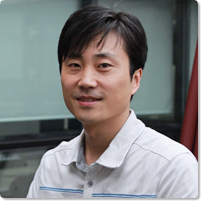
Suh Myung-Gu
Born 1974. Graduate of Sungkyunkwan University majoring in public administration, and then majored in business administration graduate school. He then joined the company Metaa Culture as Value and was involved in the production of numerous performance works in the areas the traditional arts and crossover “Dawon arts,” including productions touring to countries like the UK, France, Belgium the Netherlands and Switzerland. Suh has participated in planning of a wide range of international exchange programs and festival programming, including the Korea-EU Amity Commemorative Culture Program, a cooperative exchange program with the Mongolia Arts Committee and the Mongolia National University of Arts and Culture, the World Voices Festival, the World Peace Festival and the Asia Pacific Week Berlin. He has also been involved in arts program development and community culture research projects. From 2009, Suh has served as manager of the Mullae Arts Village of the Seoul Foundation for Arts and Culture, concentrating his activities in the areas of arts creation and new arts support systems for arts and culture in the Seoul Art Spaces and community-based arts environment support. He has developed and implemented a 3-dimensional arts/culture support system map connecting the Seoul Foundation for Arts and Culture’s arts support grants programs and the Seoul Art Spaces, and runs a community Alternative Space Network and a Performing Arts Network and other programs that stimulate the arts in communities.
Interviewer: Noriko Kimura (Seoul-based performing arts coordinator, translator)
Mullae Arts Village
5-4 Gyeonginno 88-gil, Yeongdeungpo-gu (Mullae-dong 1(il)-ga)), Seoul, South Korea
Phone: +82-2-2676-4331
Fax +82-2676-4646
https://cafe.naver.com/mullaeartspace/
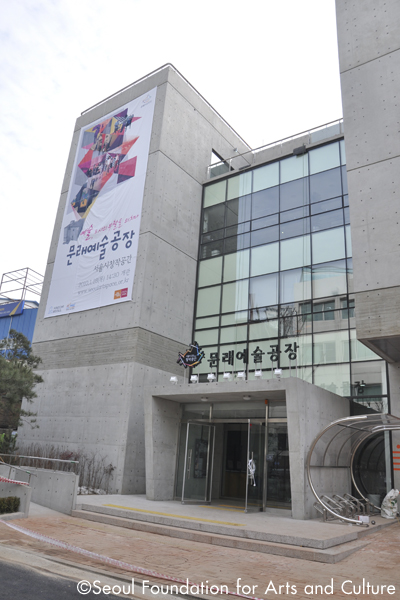
Seoul Art Space
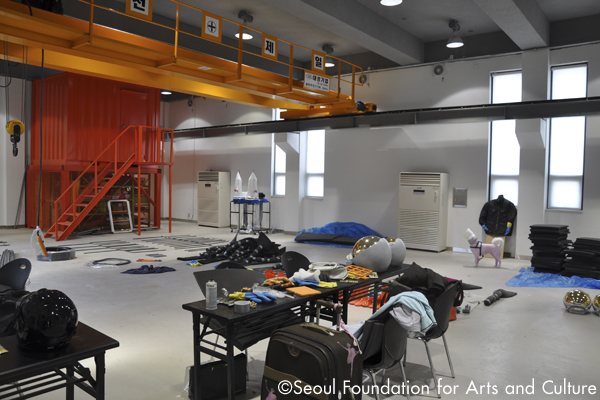
Mullae Arts Village – StudioM30
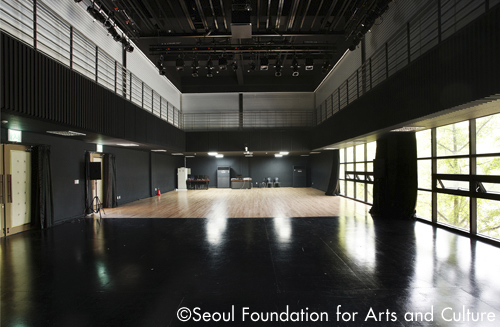
Mullae Arts Village – Box Theatre

Theater Momggol production
The Rusty Times
(2011)
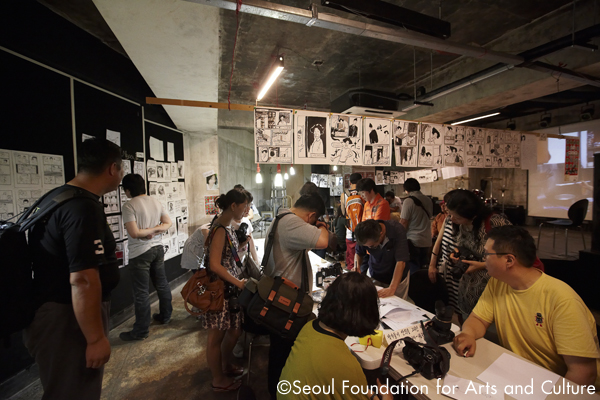
Community program MEET Project “24 Hour Mangrove Project”
(Sep, 2011)
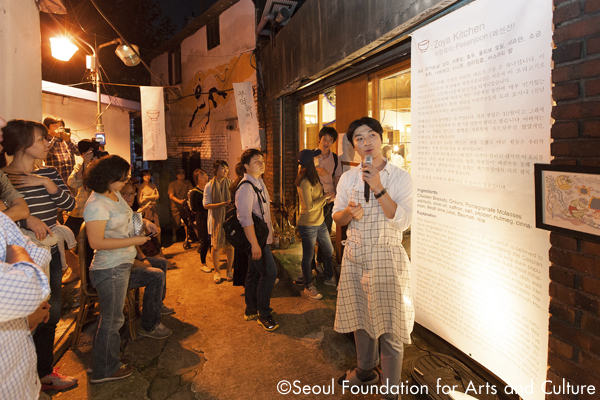
Community program MEET Project “Kitchen Play – International Banquet”
(Sep. 2012)
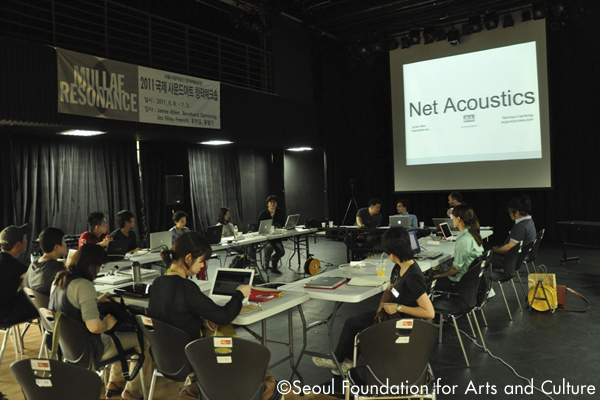
International Sound Art Creative Workshop
(Jun. 2011)
Related Tags

